1997 CHEVROLET BLAZER brake light
[x] Cancel search: brake lightPage 6 of 402
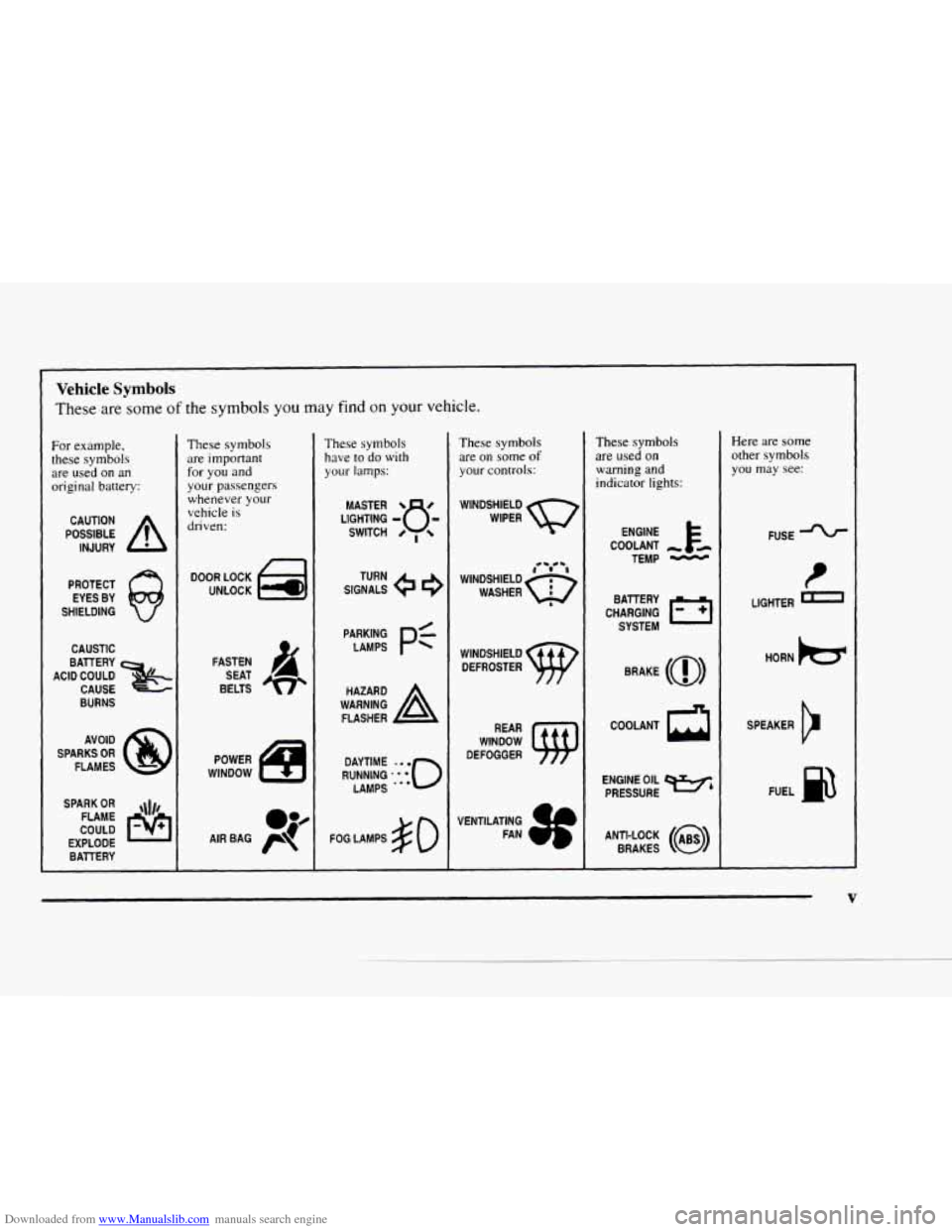
Downloaded from www.Manualslib.com manuals search engine Vehicle Symbols
These are some of the symbols you may find on your vehicle.
For example,
these symbols
are used on an
original battery:
POSSIBLE A
CAUTION
INJURY
PROTECT EYES BY
SHIELDING
CAUSTIC
ACID COULD
x
BATTERY CAUSE
BURNS
AVOID
SPARKS
OR
FLAMES
SPARK
OR ,\I/,
COULD FLAME
EXPLODE BATTERY
These symbols
are important
for you
and
your passengers
whenever your
vehicle
is
driven:
DOOR LOCK
UNLOCK
These symbols have
to do with
your lamps:
FASTEN
SEAT
BELTS
POWER
WINDOW
't -I
SIGNALS TURN
A
FLASHER
FOG LAMPS
$0
These symbols
are
on some of
your controls:
WINDSHIELD
WIPER
WINDSHIELD DEFROSTER
WINDOW
DEFOGGER
VENTILATING FAN
1 b
-J
These symbols
are used on
warning and
indicator lights:
COOLANT
TEMP
-
CHARGING EATERY
SYSTEM
BRAKE
(a)
ENGINE OIL e,
PRESSURE
ANTI-LOCK
(@)
BRAKES
Here are some
other symbols
you may see:
FUSE *
I
LIGHTER
HORN
)a(
SPEAKER
b
FUEL la
V
Page 58 of 402

Downloaded from www.Manualslib.com manuals search engine Section 2 Features and Controls
Here you can learn about the many standard and optional features on your vehicle, and information on starting,
shifting and braking.
Also explained are the instrument panel and the warning systems that tell you if everything is
working properly -- and what to do if you have a problem.
2-2
2-6
2-9
2- 12
2-13
2-
13
2- 15
2-
17
2-18
2-2 1
2-23
2-23
2-23
2-29
2-30
2-33 Keys
Keyless Entry
System
(If Equipped)
Endgatekiftgate
Theft
New Vehicle “Break-In”
Ignition Positions
Starting Your Engine
Engine Coolant Heater (Option)
Automatic Transmission Operation
Manual Transmission
Locking Rear Axle
All-Wheel Drive (If Equipped)
Four-wheel Drive (If Equipped)
Parking Brake
Shifting Into
PARK (P) (Automatic
Transmission Models Only)
Shifting Out
of PARK (P)
(Automatic Transmission) 2-33
2-34
2-34
2-35
2-36
2-38
2-45
2-49
2-63
2-63
2- 64
2-67
2-72 Parking
Your Vehicle (Manual Transmission
Models Only) Parking Over Things That Burn
Engine Exhaust
Running Your Engine While You’re Parked
(Automatic Transmission)
Windows
Turn SignaVMultifunction Lever Exterior Lamps
Mirrors
Accessory Power Outlets (If Equipped)
Sunroof
(If Equipped)
Universal Transmitter
(If Equipped)
Instrument Panel
Warning Lights, Gages and Indicators
Page 79 of 402
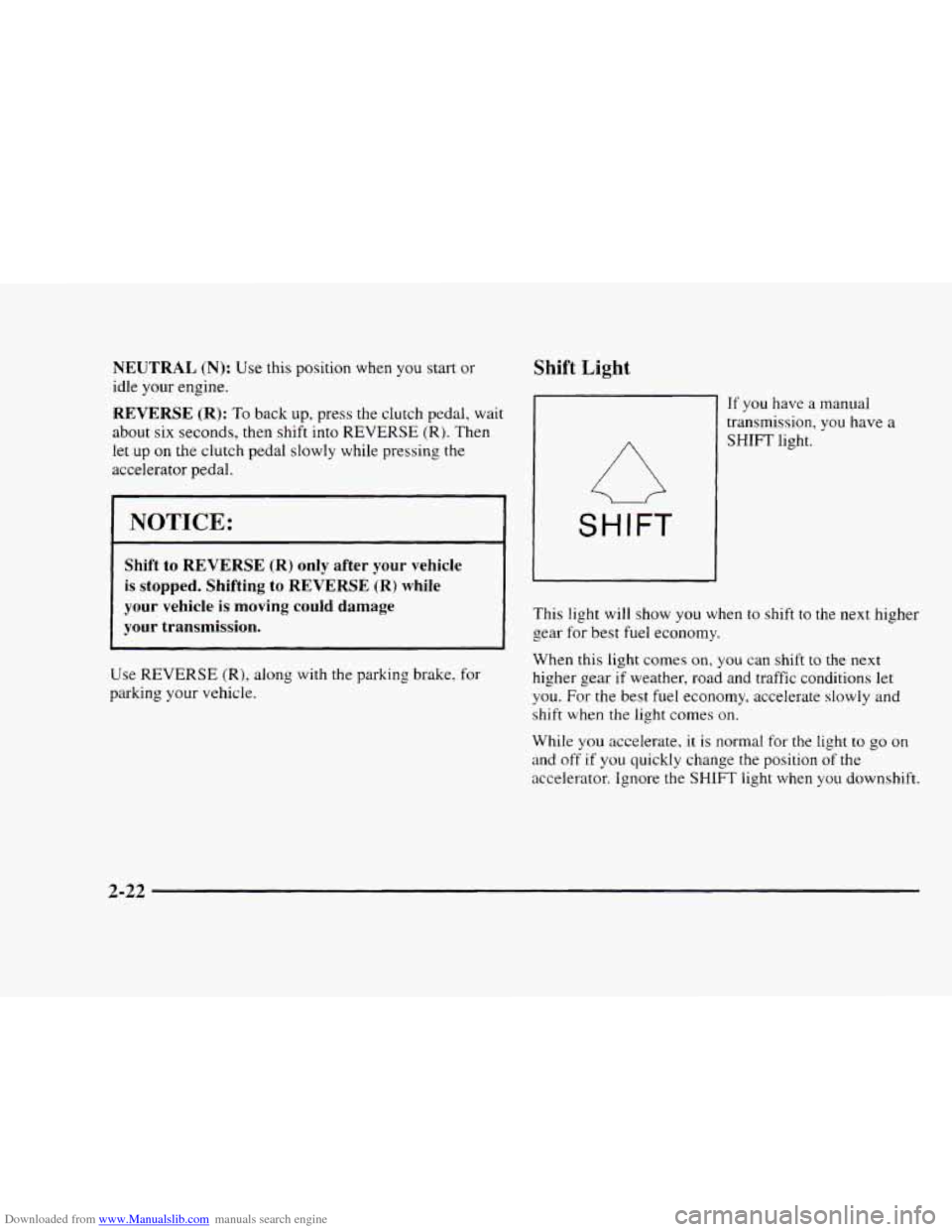
Downloaded from www.Manualslib.com manuals search engine NEUTRAL (N): Use this position when you start or
idle your engine.
REVERSE (R): To back up, press the clutch pedal, wait
about six seconds, then shift into
REVERSE (R). Then
let up
on the clutch pedal slowly while pressing the
accelerator pedal.
NOTICE:
Shift to REVERSE (R) only after your vehicle
is stopped. Shifting to REVERSE (R) while
your vehicle is moving could damage
your transmission.
Use REVERSE (R), along with the parking brake, for
parking your vehicle.
Shift Light
SHIFT
If you have a manual
transmission, you have
a
SHIFT light.
This light will show you when
to shift to the next higher
gear for best fuel economy.
When this light comes
on, you can shift to the next
higher gear if weather, road and traffic conditions let
you. For the best fuel economy, accelerate slowly and
shift when the light comes
on.
While you accelerate. it is normal for the light to go on
and off if you quickly change the position of the
accelerator. Ignore the SHIFT light when you downshift.
2-22
Page 81 of 402
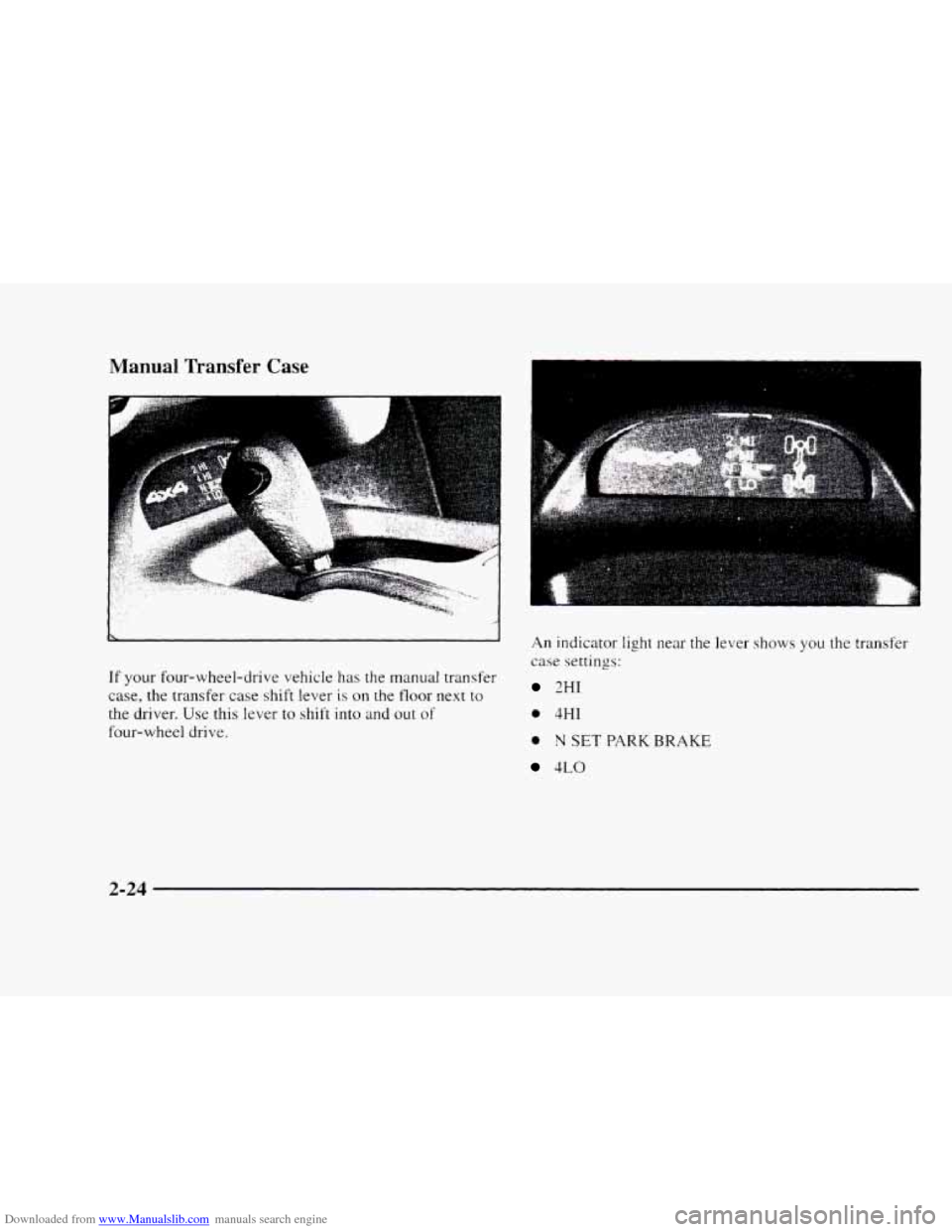
Downloaded from www.Manualslib.com manuals search engine Manual Transfer Case
If your four-wheel-drive vehicle has the manual transfer
case,
the transfer case shift lever is on the floor next to
the driver. Use this lever to shift into and out of
four-wheel drive.
An indicator light near the lever shows you the transfer
case settings:
2HI
0 4HI
0 N SET PARK BRAKE
4LO
2-24
Page 82 of 402

Downloaded from www.Manualslib.com manuals search engine The front axle portion of the diagram on the indicator
will light up when you shift
into four-wheel drive. A
slight delay between shifting and the pattern’s lighting is
normal. If the pattern does not light up, or if the front
axle lights do not go out after you shift out of
four-wheel drive, have your dealer check your system.
Turn the INT LIGHTS switch located to the right of
your headlamp switch
to dim your transfer case
indicator light when your headlamps or parking lamps
are on. This will also cause your instrument panel lights
to dim.
2HI: This setting is for driving in most street and
highway situations. Your front axle is
not engaged in
two-wheel drive.
4HI: This setting engages your front axle to help
drive
your vehicle. Use 4HI when you need extra
traction, such as on snowy
or icy roads, or in most
off-road situations.
N SET PARK BRAKE: Shift to this neutral setting
only when your vehicle needs to be towed.
4LO: This setting also engages your front axle to give
you extra traction and provides extra gear reduction.
You may never need 4LO. It sends the maximum power
to all four wheels. You might choose 4LO if you were
driving off-road in sand, mud or deep snow and
climbing or descending steep hills.
You can shift from 2HI to 4HI or from 4HI to 2HI while
the vehicle is moving. Do not press the transfer case
shift lever button when shifting from 2HI
to 4HI or
from 4HI to 2HI.
To shift your transfer case into N SET PARK BRAKE:
1. Stop the vehicle and shift your transmission into
NEUTRAL
(N).
2. Set the parking brake. Your vehicle can roll unless
the brakes are applied.
3. Pull the transfer case shift lever into N SET
PARK BRAISE.
2-25
Page 86 of 402
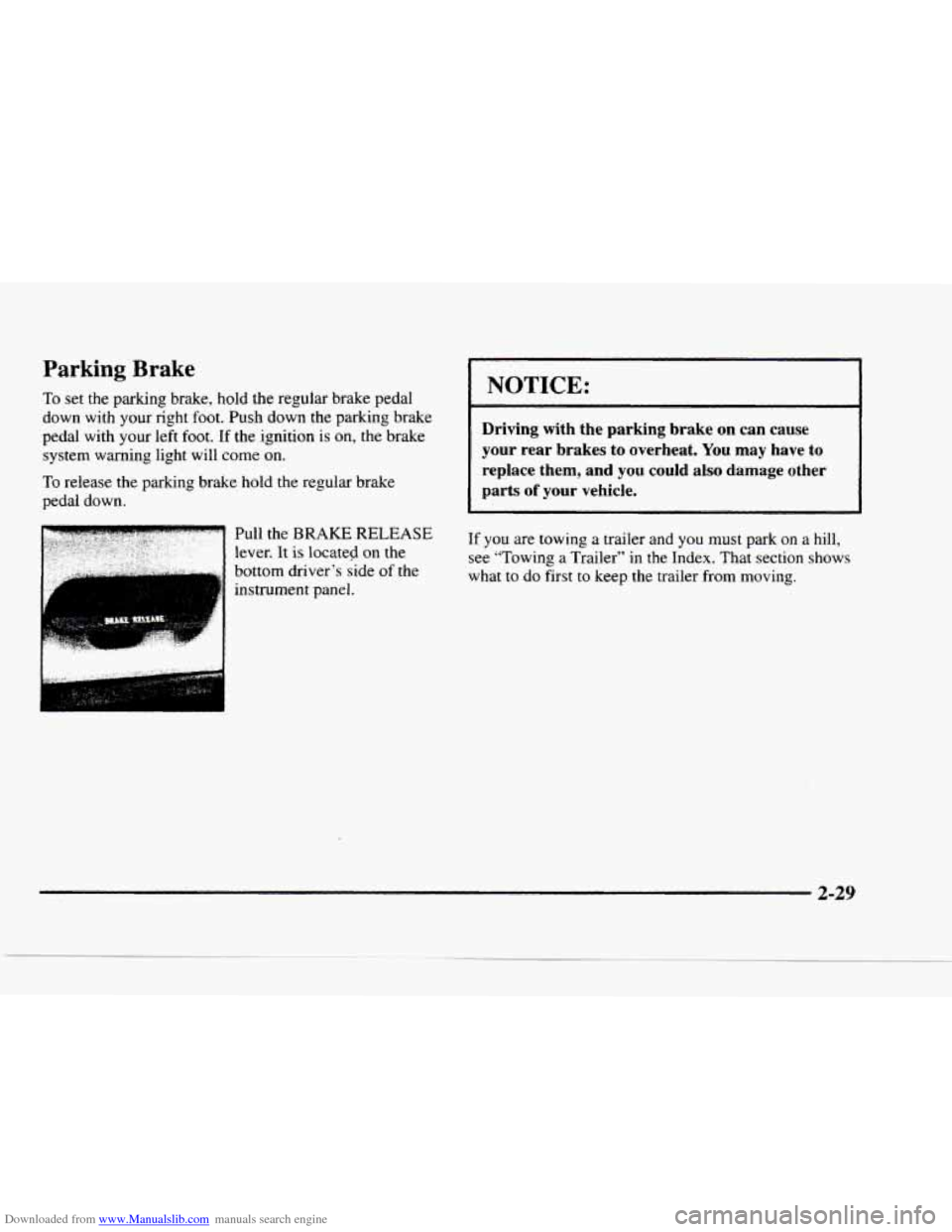
Downloaded from www.Manualslib.com manuals search engine Parking Brake
To set the parking brake, hold the regular brake pedal
down with your right foot. Push down the parking brake
pedal with your left
foot. If the ignition is on, the brake
system warning light will come
on.
To release the parking brake hold the regular brake
pedal down.
Pull the
BRAKE RELEASE
lever. It is located on the
bottom driver’s side
of the
instrument panel. ..
NOTICE:
r
Driving with the parking brake on can cause
your rear brakes to overheat.
You may have to
replace them, and you could also damage other
parts
of your vehicle.
If you are towing a trailer and you must park on a hill,
see “Towing a Trailer” in the Index. That section shows
what to do first to keep the trailer from moving.
2-29
Page 101 of 402
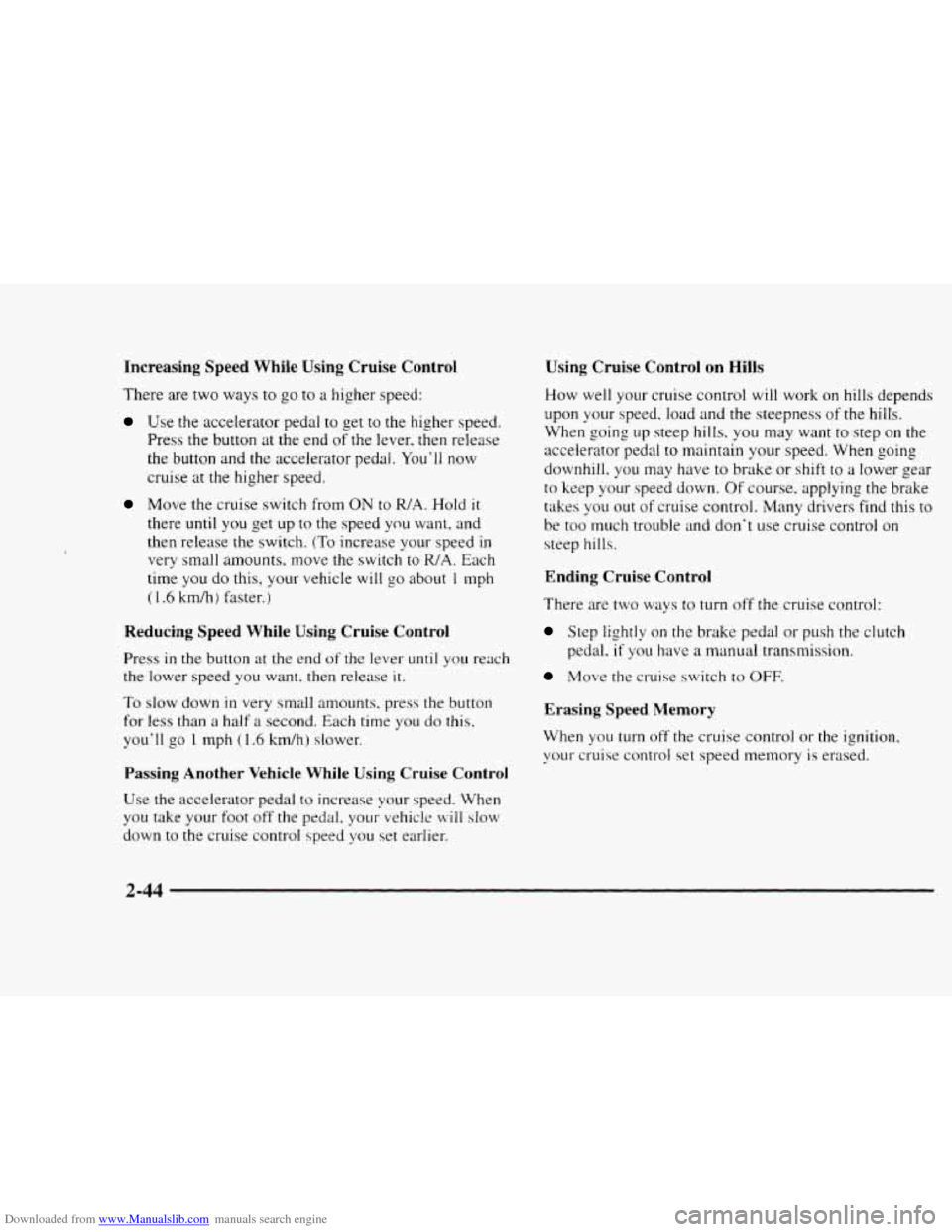
Downloaded from www.Manualslib.com manuals search engine Increasing Speed While Using Cruise Controi
There are two ways to go to a higher speed:
Use the accelerator pedal to get to the higher speed.
Press the button at the end of the lever, then release
the button and
the accelerator pedal. You'll now
cruise at the higher speed.
Move the cruise switch from ON to R/A. Hold it
there until you get up to the speed you want. and
then release the switch.
(To increase your speed in
very small amounts. move the switch to R/A. Each
time
you do this, your vehicle will go about 1 mph
(1.6
km/h) faster.)
Reducing Speed While Using Cruise Control
Press in the button at the end of the lever until you reach
the lower speed you want. then release it.
To slow down in very small amounts, press the button
for less than a half a second. Each time you do this.
you'll
go 1 mph ( I .6 kndh) slower.
Passing Another Vehicle While Using Cruise Control
Use the accelerator pedal tu increase your speed. When
you take your foot off the pedal. your vehicle \vi11 slow
down to the cruise control speed you set earlier.
Using Cruise Control on Hills
How well your cruise control will work on hills depends
upon your speed. load and the steepness
of the hills.
When going
up steep hills. you may want to step on the
accelerator pedal to maintain your speed. When going
downhill, you may have
to brake or shift to a lower gear
to keep your speed down. Of course. applying the brake
takes
you out of cruise control. Many drivers find this to
be too rnuch trouble and don't use cruise control on
steep hills.
Ending Cruise Control
There are two ways to turn off the cruise control:
Step lightly on the brake pedal or push the clutch
pedal,
if you have a manual transmission.
Move the cruise switch to OFF.
Erasing Speed Memory
When you turn oft' the cruise control or the ignition.
your cruise control set speed memory
is erased.
2-44
Page 103 of 402

Downloaded from www.Manualslib.com manuals search engine Lamps On Reminder
A reminder tone will sound when your headlamps or
parking lamps are turned on and your ignition
is in OFF,
LOCK or ACCESSORY. To turn the tone off, press the
OFF switch.
Daytime Running Lamps
Daytime Running Lamps (DRL) can make it easier for
others to see the front
of your vehicle during the day.
DRL can be helpful
in many different driving
conditions. but they can be especially helpful
in the
short periods after dawn and before sunset.
The DRL system will make your headlamps come on at
reduced brightness when:
the ignition is on,
the headlamp switch is off and
the parking brake is released. When
the DRL are
on, only your headlamps will be on.
The taillamps, sidemarker and other lamps won’t be on.
The instrument panel won’t be lit up either.
When it begins to get dark, your
DRL indicator light is a
reminder to turn your headlamp switch on. The other
lamps that come on with your headlamps will also
come
on.
When you turn the headlamp switch off, the regular
lamps will
go off, and your headlamps will change to
the reduced brightness
of DRL.
To idle your vehicle with the DRL off, set the parking
brake. The DRL will stay off until you release the
parking brake.
As with any vehicle, you should turn on the regular
headlamp system
when you need it.
2-46